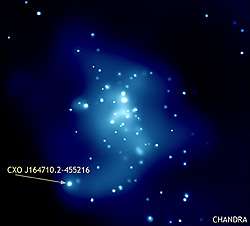Stellar Switch-a-roo

Sometimes even scientists can be fooled. In a cosmic bait and switch, astronomers with NASA's Chandra X-ray Observatory have spotted an enormous star that pulled a fast one while collapsing and left them to figure out why.
"Our discovery shows that some of the most massive stars do not collapse to form black holes as predicted, but instead form neutron stars," said Michael Muno, a University of California-Los Angeles research scientist studying the phenomenon.
Image: The tricky neutron star sits inside a cluster of stars named Westerlund 1. The star is rapidly spinning and approximately 12 miles in diameter. Credit: NASA/CXC
The cosmic trickster in this galactic prank appears to be a new neutron star residing in a stellar cluster known as Westerlund 1. Before becoming a neutron star, the original object was what astronomers call a massive star. The initial star is estimated to have been at least 40 times the size of the sun. When a star that large dies, it sheds its matter in a violent explosion. Normally, scientists expect the blast to leave behind an object so dense that not even light can escape its immense gravity: a black hole. But in this instance, the giant star surprisingly produced the less-dense neutron star we see today.
Despite its lower density, the surviving neutron star is no lightweight. Tightly packed with tiny atomic particles called "neutrons," a thimbleful of the star weighs 100 million tons and its gravity would cause a 150-pound person to tip the scale at 1 million tons.
When the parent star exploded, it sent nearly 95 percent of its mass into space. "This means that enormous amounts of heavy elements are put back into circulation and can form other stars and planets," said co-researcher J. Simon Clark of the Open University in the United Kingdom.
The cast-off star-stuff appears to have fertilized the region around the remaining neutron star, likely spawning a new generation of conventional stars. Westerlund 1 now contains more than one hundred thousand smaller stars in an area only 30 light years across. The size and closeness of the stars confirms they were all likely created at the same time and from a single event.
This new discovery comes as the Chandra X-ray Observatory celebrates its sixth year studying the universe. Launched aboard space shuttle Columbia in 1999, Chandra opened our eyes to the brilliant cosmos only visible in X-ray light. From its high orbit in space, the telescope has revealed startling discoveries like new classes of black holes, webs of intergalactic matter threading through space and intense flares protecting fledgling planets.
The discovery that a neutron star formed in Westerlund 1 -- and a black hole didn't -- may have caught astronomers off guard, but it's a positive lesson for one and all. The creation of the new neutron star helps to shed light on the dark mysteries of black holes. In a sense, scientists are learning more about what a black hole isn't from this event than what a black hole is. The lessons learned will help astronomers determine which stars will form black holes in the future, so the scientists won't be fooled again.
Source: by Charlie Plain, NASA's Chandra X-ray Observatory and John F. Kennedy Space Center
















